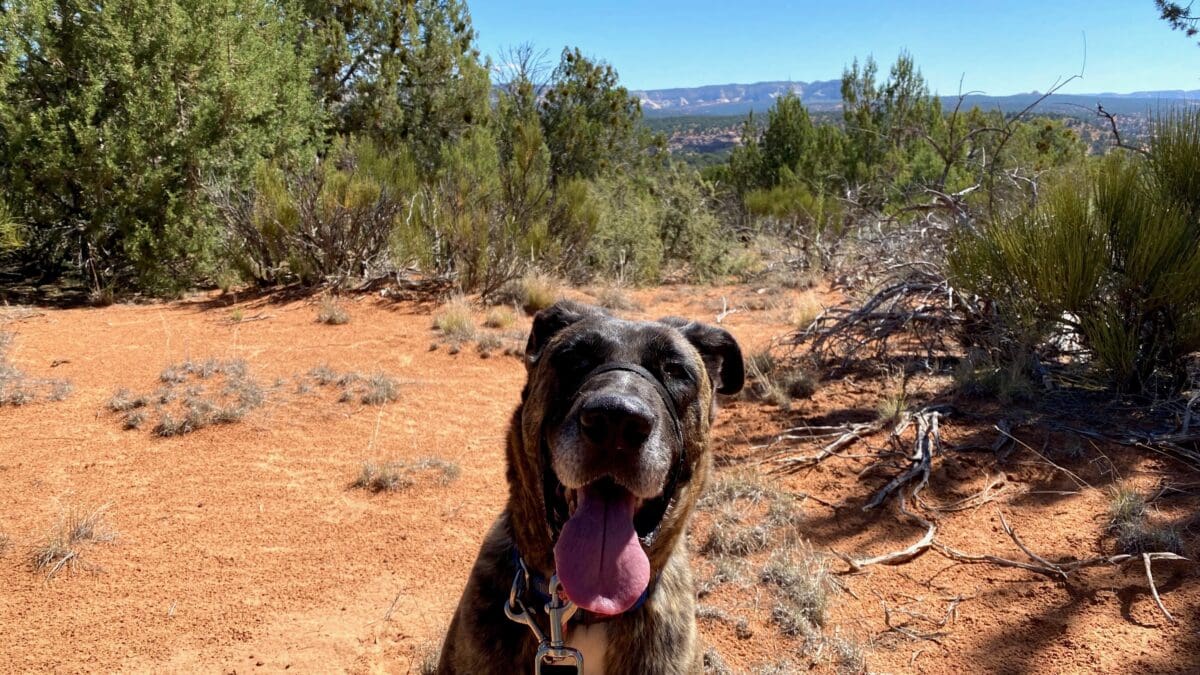Neighbors Magazines
How fostering animals benefits both pets and rescuers in Park City

Pup smiling on a trail. Photo: Layne Dicker
By: Julie Hooker Dicker, Neighbors of Park City
From the outside, people think I am a “foster failure”—someone who fostered an animal for a shelter or rescue, fell in love with it, and never returned the foster pet. The truth is, I am. But I am also in awe of the people who really foster, the folks who open up their homes—and hearts—to the animals who need it the most. Those folks are the real heroes of rescue, and I am grateful.
My first foster fail was Houston. A Texas rescue posted his picture, noting that he was deaf and needed a place until he found his forever home. I thought, “Okay. I can do this. I will teach him sign language and help him find his family.”
When Houston arrived at the Salt Lake Airport, I scooped him out of his travel kennel and took him to meet my mother. It turned out that Houston’s pupils were not round; they were like starbursts. He could not see very well. This would make it difficult for him to learn sign language. Houston was mine.
“Fosters are what keep the rescue community functioning,” says PJ Saylor of FetchCares. “When we meet a dog that needs saving, we often need a place for that dog to safely land until we see what’s what.” During this time, the dog can be assessed for medical and behavioral concerns.
Of fosters, PJ shares, “They have one of the hardest jobs. They take the dog when it is at its worst, they love it to its best, and then say ‘goodbye’ as it goes to its forever home. Then, they step up and do it again. It takes a big ole warm, loving heart. But, it’s worth it.”
Recently, I took an Animal Welfare course through Southern Utah University and Best Friends Animal Society. In it, I learned five reasons fostering is essential to reaching No Kill in 2025.
- Shelters can be loud. Inside a shelter, dogs may not behave “normally.” When a pet leaves a shelter, many behaviors that may have been a concern often disappear.
- When in a foster home, a great deal can be learned about a pet that will aid in marketing him or her toward finding a permanent home. For example, a few weeks ago, I fostered a puppy overnight. Since I have dogs and a cat, we learned the puppy did not have a prey drive toward the cat and that he got along well with other dogs of all ages, shapes, and sizes.
- Pets are often adopted directly from foster homes without returning to the shelter. This frees up critical resources for other pets in need.
- When a shelter is at capacity (as so many of our local shelters are), or in the case of emergencies (like fire or flood), placing pets in foster homes allows the shelter to save more pets rather than end lives due to lack of space.
- Fostering is an excellent option for the most at-risk animals, such as newborn puppies and kittens, who need 24/7 care.
In Summit County, our rescues have robust foster programs, but more are still needed. Heidi Black, from Paws for Life Utah, notes, “We provide all of the supplies a foster will need.”
She continues, “I never thought I would be strong enough to get involved in rescue. I love animals so very much. But, knowing the end result, how could I not? Do I tear up when my fosters find their happy forever homes? Of course! If you have a passion for animals, I encourage you to join an animal rescue organization. You will not regret it.”
Echoing PJ and Heidi, Danielle Barnhart, Senior Manager of Lifesaving Programs for Best Friends Animal Society, shares, “I foster a lot of our special needs and senior cats for the Lifesaving Center, so I can attest to a positive impact firsthand.” Currently, Danielle is fostering two incontinent cats and a kitten with back leg paralysis.
Barnhart continues, “For an individual animal, a break from a shelter environment, even for one night, can have a big impact on their mental and physical health. Even the facilities with amazing contagion control practices and daily enrichment routines just can’t compare to the individualized care animals receive in a foster home. Shelters and rescues are often limited in how many animals they can help at a time based on their kennel space, so every time a person becomes a foster caregiver, the shelter/rescue’s capacity for intake increases. Foster programs allow so many more animals to be saved and give those animals a comfy environment to relax in while they wait for their adoptive home.”
Years ago, I fostered three kittens. Using social media, I posted the kittens daily, sometimes more. In my home, I called them Scout, Jem, and Boo. By the time I took them to the kitten adoption event at The Barking Cat, all three were spoken for. Foster families networking with their friends leads to quicker adoption.
With fostering, you determine the length of stay. Fosters work as a team. For example, a long-term foster may need to leave town for a few days. This is when another foster takes over for a short time.
After my three kittens went to their forever homes, a foster adopted a mama dog about to give birth and knew it would be better if her foster kitten went to another home. I took him, I failed, and Harold became mine.
In addition to fostering newborns and pets with medical needs, senior pets need loving homes where they can relax. Some of my most rewarding fosters were actually “Fospice.” These dogs became part of my family until their very last breath.
Spring is “kitten season” in the foster community, a great time of year to support local rescues. Do you have room in your home and your heart for fostering?
Photos by Layne Dicker.



















